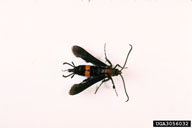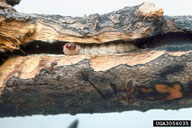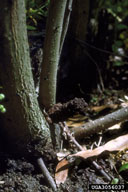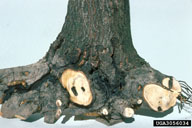Persimmon borer
Sannian uroceriformis Walker (Lepidoptera: Sesiidae)
Orientation to pest
Persimmon borer, Sannian uroceriformis Walker, is a native North American clearwing moth found in the eastern United States. The larvae feed in the wood of the lower trunk and tap roots of the American persimmon tree, Diospyros virginiana L. Moths emerge in spring and mate. Females either lay their eggs on tree bark or drop them at the base of the host tree. After hatching, larvae move to suitable parts of the host tree and burrow into the bark. Larvae tunnel in the cambium downward, and when they are at or near the soil line, tunnel into the wood toward the center of the tap or lateral roots. Larvae overwinter in their galleries below the soil line and when ready to pupate extend their galleries upward in the roots to the ground line or just above. Trees growing in cutover areas and in hedgerows have higher infestation rates, as do young trees in nurseries. The life cycle takes 2-3 years to complete.
Hosts commonly attacked
This borer attacks only persimmons, particularly the native wild persimmon of the United States (D. virginiana).
Distribution
This borer occurs is found in the United States along the Atlantic coast from New Jersey to Florida, and west to Kansas, Texas, Missouri, Ohio and Indiana.
Images of persimmon borer
| Figure 1. Adult of persimmon borer, Sannian uroceriformis | Figure 2. Larva of persimmon borer | Figure 3. Pupation tubes of persimmon borer pushed out of larval galleries | Figure 4. Galleries of persimmon borer larvae in roots of host tree |
Important biological control agents related to this pest species
No natural enemies of this species have been recorded.
Web links for information on persimmon borer
- Entomology Publication #ENY-835 | University of Florida IFAS Extension EDIS
- BugwoodWiki Article | wiki.bugwood.org
Articles
- Solomon, J. D. 1995. Guide to Insect Borers in North American Broadleaf Trees and Shrubs. Agriculture Handbook No. AH-706, see pp. 56-57, USDA Forest Service, Washington, D. C., 735 pp.







